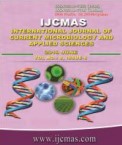


 National Academy of Agricultural Sciences (NAAS)
National Academy of Agricultural Sciences (NAAS)

|
PRINT ISSN : 2319-7692
Online ISSN : 2319-7706 Issues : 12 per year Publisher : Excellent Publishers Email : editorijcmas@gmail.com / submit@ijcmas.com Editor-in-chief: Dr.M.Prakash Index Copernicus ICV 2018: 95.39 NAAS RATING 2020: 5.38 |
A comparative evaluation of the use of thermal, microwave and irradiation treatments for pasteurization of ready to serve watermelon juice was undertaken to study their relative impact on residual enzyme (polyphenol oxidase and peroxidase) activities microbial population, and sensorial changes during its refrigerated storage for a period of three months. Pasteurization using thermal and microwave treatments could effectively control the microbial load within the acceptable limit (<1 log cfu mL−1) over the entire three months of storage. Irradiation treatment of 0.5kGy resulted in the lowest residual polyphenol oxidase (RAPPO) activity followed by the microwave (1.56W/ml) and thermal treatments. However, maximum reduction in peroxidase activity (RAPOD) was achieved using thermal and microwave treatments. At the end of the three months storage, watermelon juice pasteurized using microwave energy was sensorially found to be the most acceptable product.
 |
 |
 |
 |
 |